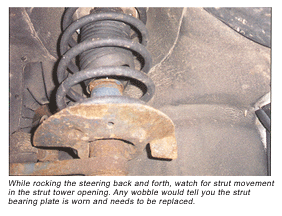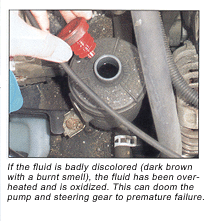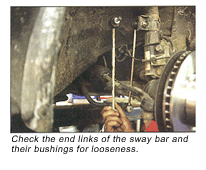
Home, Auto Repair Library, Auto Parts, Accessories, Tools, Manuals & Books, Car BLOG, Links, Index

How to Inspect Your Car's Suspension
Copyright AA1Car.com


Copyright AA1Car.com
The suspension or chassis is not something to neglect because it supports your vehicle and affects steering, handling, braking, tire wear and ride. How many times have you seen a vehicle broken down on the side of the road with a collapsed suspension because a ball joint failed, or the front wheels are splayed in opposite directions because a tie rod end separated? Fortunately, these kinds of catastrophic failures don't happen that often, but when they do they can have tragic consequences.
So here are some of the things you should inspect or check on your vehicle's steering and suspension when doing brake work, changing tires, exhaust repairs or an oil change.

Unusual tire wear is a dead giveaway that a vehicle has either an alignment problem or worn/damaged steering or suspension parts. What to look for:
If toe wear is accompanied by steering looseness or steering wander, there is a very good chance the tie rod ends are worn. Proceed to the steering checks. If toe wear is accompanied by a steering pull or off-center steering, rear wheel toe alignment or axle alignment may be out of specification.

The steering can be inspected in one of several ways. With the full weight of the vehicle on the wheels, have a helper rock the steering wheel while you look for play or looseness in the steering linkage and steering column. On some vehicles, this can be done by reaching up and rocking the steering column coupling from underneath while the vehicle is sitting on a drive-on ramp style lift. The dry park method of checking for looseness is generally the best procedure to use because the weight of the vehicle on the wheels creates resistance that makes it easier to see play.
The dry park method is also a good way to find loose upper strut bearing assemblies. While rocking the steering back and forth, watch for strut movement in the strut tower opening. Any wobble would tell you the strut bearing plate is worn and needs to be replaced.
As a rule, tie rod ends should show no visible vertical or horizontal play during the dry park check.
The inner tie rod sockets on rack & pinion steering gears are enclosed in bellows, making them difficult to inspect. If the bellows are rubber, you can check for looseness by squeezing the bellows and pinching each socket while pushing outward on the wheel or while a helper rocks the steering wheel. If you feel movement, the sockets are loose and need to be replaced. You can't do this check with hard plastic bellows, so lock the steering wheel with a holder and watch for any in or out movement in the tie rod while pulling and pushing on the wheels.
Also pay attention to the rack mounts. Loose, deteriorated or broken mounts may allow the rack housing to move as the wheels are turned. This can cause steering wander and noise.
With reciprocating ball steering systems, pay close attention to the amount of play in the idler arm. Looseness here can cause steering wander and toe wear. Pitman arms should show no vertical looseness. Center links should be like tie rod ends and show no vertical or horizontal play.
If the vehicle is not your own, take it for a test drive. Pay attention to things like steering effort, return, stability, feel and noise.

Steering effort on both manual and power systems should be checked with the weight of the vehicle on the wheels. Unusually high effort combined with poor steering return may indicate a weak pump or a worn spool valve in the steering rack. Other causes of increased steering effort can include binding in the steering rack, improper rack yoke adjustment, and binding in tie rod ends, ball joints or upper strut bearing assemblies. Power steering can also be checked with the wheels off the ground. If the steering wants to turn to one side when the engine is running, it indicates a problem in the control valve.
Don't forget to check the fluid level in the power steering pump reservoir, too. A low level may indicate leakage. A visual check of the pump, hoses and steering gear should reveal the source.
If the fluid is badly discolored (dark brown with a burnt smell), the fluid has been overheated and is oxidized. This can doom the pump and steering gear to premature failure (if they have not suffered damage already). Replacing the fluid may buy these parts some time.
Some hissing noise is normal with most power steering systems, but excessive noise may indicate a bad check valve. Belt squeal would tell you the belt needs to be tightened or replaced. Pump noise usually indicates wear.
Check the wheel bearings for play before proceeding on to the ball joints, because play here can mimic loose suspension parts and contribute to steering wander and instability.
Start by raising the wheels off the ground and spinning each wheel by hand to check for roughness or noise in the bearings. Do not confuse normal brake drag for bearing noise. If the bearings are rumbling or clicking, removal for cleaning and further inspection will be necessary unless the bearings are the sealed variety, in which case replacement would be required if they are making noise, loose or rough.
To check wheel bearing play, grasp the wheel at the top and bottom, then try to rock it back and forth by pushing in with one hand while simultaneously pulling outward with the other hand. Alternate back and forth to see if the wheel rocks or moves. If you feel movement, the bearings are loose. Refer to specifications for the maximum allowable play.

Serviceable wheel bearings on older vehicles should be removed, cleaned, inspected, repacked with fresh grease (new grease seals, too!) every 30,000 miles for preventive maintenance. They should also be removed, cleaned and inspected if the vehicle has been in hub-deep water, or if the bearings feel loose or out of adjustment.
If a sealed bearing and hub assembly is loose, feels rough when spun by hand or is making noise, it needs to be replaced.
If the ball joints have built-in wear indicators, joint play should be checked with the weight of the vehicle on the wheels. Ball joints without built-in wear indicators are generally checked by raising the suspension to take the weight off of the joints. Procedures vary.
On rear-wheel drive applications with SLA suspensions where the spring is on the lower control arm, modified strut suspensions which also have the spring on the lower control arm, and front-wheel drive wishbone strut suspensions where the spring is on the strut, but the strut is connected to the lower control arm, the lower ball joints carry the weight and must be unloaded to measure play. This is done by raising the vehicle and supporting the lower control arms to take the weight off the lower ball joints, then pulling on or prying against the wheel (not the ball joint!) to measure vertical and horizontal play in both the lower and upper ball joints. Also, make sure the ball joint is securely attached to the control arm by looking for any signs of movement between the housing and arm.
If an SLA suspension has the coil spring over the top arm, the upper joints are loaded. To check these joints, the vehicle has to be raised and the upper control arms blocked or supported to unload the upper joints.
With MacPherson struts, the strut supports the load, so the lower ball joints are unloaded. To measure play, simply raise the vehicle and allow the suspension to hang free. Then push on or pry against the wheel to measure vertical and horizontal play in the lower ball joints.
To check rear ball joints on a FWD car with an independent rear suspension, raising the wheels and supporting the suspension arms will unload the joints.
Note: All ball joints should be checked prior to lubricating the chassis (if joints are greaseable) because grease may temporarily take up slack in the joint.
The amount of horizontal (radial) and vertical (axial) play that is allowed in a ball joint will vary depending on the joint type, location and vehicle application. Always refer to the vehicle manufacturer specifications, and use a dial indicator to measure the amount of play unless the joint is obviously shot.
Front control arms, as well as rear trailing arms and lateral links, should all be visually inspected for damage or cracks. Also, make sure the ball joint is securely attached to the arm.

Check the bushings for excessive movement, deterioration, cracking or crush. This can be done by gently prying against the control arm to see if the bushings allow much movement. A little "give" with rubber and elastomer bushings is normal, but if you see more than about 1/8 inch, it may mean the bushing has collapsed. Metal bushings should have little or no play. Bouncing the suspension can help you identify noisy bushings.
On sway bars, check the sway bar bushings and mountings. The mountings should be securely attached to the chassis, and the bushings should be in good condition (no cracks, splits, crushing, etc.). Check the end links of the sway bar and their bushings, too, for looseness. If the ends of the sway bar are attached directly to the control arms, check to see that the mounting is secure.
A "bounce test" will usually reveal shocks that are badly worn, but a test drive will give you a more accurate picture of their condition. If the vehicle sways excessively, rocks, feels bouncy or otherwise lacks proper ride control, you should recommend new dampers.
When visually inspecting the shocks and strut assemblies, look for:
Any of the above conditions would call for repairs or replacement.
Measuring ride height will tell you if the springs are sagging. Notice we said "measure." That doesn't mean take a quick glance and let it go at that. It is hard to see small but significant differences in ride height side-to-side, and virtually impossible to tell if a vehicle is within the factory-specified ride height dimensions without using some type of measuring device.
If ride height is below specification, the springs are sagging and replacement is recommended. Also, keep in mind how you use your vehicle. For some applications, upgrading to variable-rate springs can provide extra load carrying capacity as well as improved handling when pulling a trailer.
Proper torque on lug nuts is very important for three reasons. One is to keep the lug nuts from loosening up and the wheel coming loose, another is to prevent distortion of the brake rotor behind the wheel, and a third is to prevent broken studs. A torque wrench should be used for final tightening of the lug nuts, and the nuts should always be torqued to the recommended specifications.
CAUTION: Torque specifications for lug nuts are always for CLEANand DRY studs and lug nuts. That means no oil, no grease, no anti-seize and no lubricants of any kind. Any of these products will reduce the friction between the threads. This may seem like a good thing to prevent rust and frozen lug nuts, but the reduction in friction means a much higher percentage of the applied torque (up to 25% or more) will go toward loading the lug nuts. The end result may be brake rotor distortion or broken studs!
Wheel studs should be cleaned with a wire brush to remove rust and dirt BEFORE the wheels are mounted. If the lug nuts are heavily rusted or have damaged threads and won't turn easily on the studs, replace the lug nuts. The same goes for any wheel studs with damaged or badly corroded threads. And remember to mount the wheels DRY with nothing on the threads.
 More Suspension Related Articles:
More Suspension Related Articles:  Click Here to See More Carley Automotive Technical Articles
Click Here to See More Carley Automotive Technical Articles